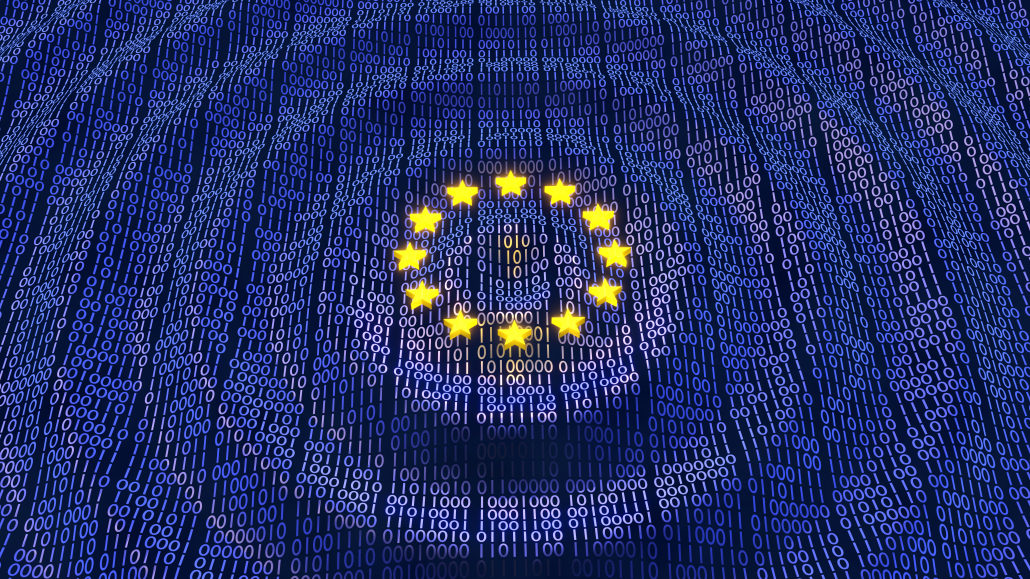IAM and GDPR: Identity Management at the Service of Compliance
The General Data Protection Regulation (GDPR) has fundamentally changed how organizations handle personal data. To comply, companies must ensure they know who accesses what data, when, and for what purpose—and they must be able to prove it. This is where Identity and Access Management (IAM)becomes essential. More than a security solution, IAM GDPR compliance is now a strategic necessity. Let’s explore how IAM becomes a cornerstone of GDPR compliance.

European Union Data Protection bits and bytes in ripple waving pattern with glowing EU stars
How IAM Supports GDPR Compliance
Access control and strong authentication
Controlling access to personal data is a core principle of GDPR. IAM helps organizations enforce Multi-Factor Authentication (MFA), Single Sign-On (SSO), and adaptive authentication, reducing the risk of unauthorized access. Whether users are employees, contractors, or partners, IAM ensures they only access the data they’re authorized to see—protecting sensitive information and reducing exposure. These capabilities are fundamental to IAM GDPR compliance.
Identity governance and access provisioning
IAM solutions provide centralized management of user identities and their permissions. They allow for automated provisioning and deprovisioning of accounts based on role changes, ensuring that access rights stay up to date. This helps enforce the principle of least privilege and minimizes the risk of over-privileged or orphaned accounts. IAM also supports regular access reviews, enabling compliance teams to easily audit and validate who has access to what.
Traceability and accountability
IAM platforms generate detailed logs of user activity, including login attempts, resource access, and changes to permissions. These audit trails are critical for demonstrating compliance during regulatory reviews and for investigating data breaches. With IAM, organizations can fulfill GDPR’s accountability requirement by providing proof of access controls and policy enforcement—another key pillar of IAM GDPR compliance.
How GDPR Impacts IAM and Compliance
Data protection by design and by default
GDPR requires that organizations implement security and privacy safeguards from the start—not as an afterthought. IAM supports privacy by design by embedding access controls and user identity verification into systems and processes from day one. This reduces the chance of accidental data exposure and ensures consistent enforcement of privacy policies across the organization.
The principle of least privilege
GDPR emphasizes that personal data should only be accessible to those who absolutely need it. IAM helps enforce this by defining clear roles, limiting access based on business function, and automatically revoking outdated permissions. This reduces the attack surface and ensures data is only accessible for legitimate, well-defined purposes.
Enabling GDPR Data Rights with IAM
Right of access, erasure, and data portability
One of the most operationally complex GDPR requirements is the ability to respond to data subject rights requests. IAM streamlines this by offering a centralized view of where personal data resides and who has access to it. When a user requests access to their data, or asks for it to be deleted or transferred, IAM makes it easier to locate the relevant information and act on it quickly and accurately—supporting IAM GDPR compliance in practice.
Consent and privacy preference management
IAM—especially Customer IAM (CIAM)—can play a crucial role in managing user consent and privacy preferences. These platforms can capture, store, and enforce user choices regarding how their data is used, shared, or processed. By integrating consent tracking into the user identity profile, CIAM ensures GDPR compliance is maintained across all applications and services.
Best Practices and Recommended Tools for IAM GDPR Compliance
IAM integration use cases for GDPR compliance
Many regulated industries—such as finance, healthcare, and the public sector—have successfully leveraged IAM to meet GDPR obligations. For instance, financial institutions use IAM to audit access to sensitive customer records, while hospitals rely on it to control who can view patient data. These use cases demonstrate how IAM is not just a security investment, but a compliance necessity.
Key IAM features for compliance success
To achieve strong IAM GDPR compliance, organizations must implement features that ensure access control, governance, and accountability. WALLIX provides a comprehensive suite of modular solutions designed to support each of these pillars:
-
Privileged Access Management (PAM)
Solutions like WALLIX PAM, Remote Access, and Web Session Manager protect sensitive systems by securing, monitoring, and auditing privileged accounts—reducing the risk of data breaches. - Identity and Access Management (IAM)
WALLIX IDaaS and Enterprise Vault enable centralized authentication and seamless access to applications, supporting secure user journeys in hybrid and cloud environments. -
Identity and Access Governance (IAG)
With WALLIX IAG, organizations can implement entitlement reviews, automate access rights, and maintain visibility—ensuring least privilege and compliance with GDPR’s accountability principle (Article 5.2). -
Security-as-a-Service
WALLIX One deliver on-demand, identity-centric security tailored for cloud-native and remote-first contexts—aligning with Zero Trust principles and privacy by design.
Additionally, selecting IAM solutions that ensure data residency within the EU, provide end-to-end encryption, and hold compliance certifications such as ISO/IEC 27001 is key to building trust and proving GDPR alignment.
WALLIX delivers on all three—helping organizations secure identities while staying compliant with European data protection regulations.
With WALLIX, GDPR compliance is built into every identity and access decision.
IAM is not just a cybersecurity tool—it’s a compliance enabler. By providing structured, auditable, and secure control over identities and access, IAM helps organizations uphold the privacy and security principles at the core of GDPR. From enforcing least privilege to managing consent and demonstrating accountability, IAM GDPR compliance transforms regulatory obligations into a competitive advantage. Organizations investing in IAM GDPR compliance not only reduce risk—they build lasting trust.
Related resources





